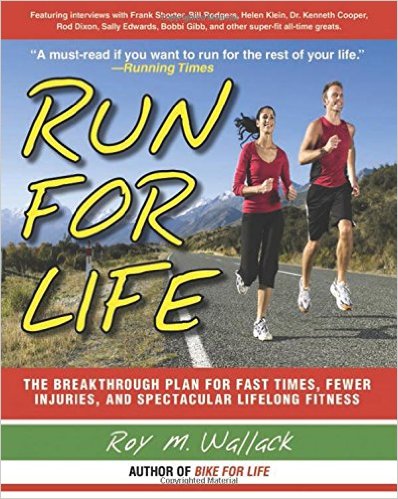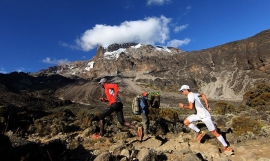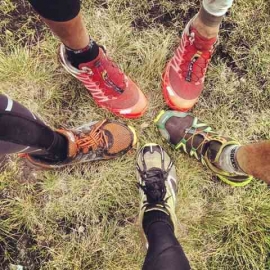Roy M. Wallack 出版书籍合集:
跑步书籍:
Barefoot Running Step by Step_Roy M. Wallack、Barefoot Ken Bob Saxton_2011
自行车书籍:
The Traveling Cyclist_Roy M. Wallack_1991
Bike for Life: How to Ride to 100_Roy M. Wallack_2005
Bike for Life: How to Ride to 100--and Beyond_Roy M. Wallack_2015
其他运动书籍:
Fire Your Gym! Simplified High-Intensity Workouts You Can Do At Home_Roy M. Wallack_2013
Run for Life: The Injury-Free, Anti-Aging, Super-Fitness Plan to Keep You Running to 100
Want to run fast and injury-free for the next 50 years? In Run for Life, the co-author of Barefoot Running Step by Step lays out a comprehensive plan designed to help you do just that. L.A. Times fitness columnist and endurance athlete Roy M. Wallack says new muscle- and joint-preserving techniques and technologies put life-long running within everyone's reach. "Yes, you can run to 100," he says. "And not merely live to 100 and shuffle along when you get there, but do what few, if any, have ever done: Actually run a 5k, 10k, or even a marathon on your 100th birthday." Traveling the running world from Kenya to Tahiti and Boston to Badwater in search of super-fit running longevity, Wallack talks to top coaches, athletes, and researchers and synthesizes new running methods, products, and fitness regimens into a life plan for runners he summarizes as: * Run Soft * Run Less * Run Stronger * Run Flexible * Run Straighter * Run Faster.
At the core of the Run for Life plan is a one-two punch that addresses the two oft-ignored factors that cripple all runners: the natural muscle and VO2 Max deterioration that starts at age 35, and the joint deterioration caused by running itself. Featuring 10 oral-history interviews and advice from greats such as Frank Shorter, Bill Rodgers, Rod Dixon, Helen Klein, Laszlo Tabori, Bobbi Gibb, and Dr. Kenneth Cooper, Run for Life brims with innovations:
·Soft Running form: The proven way to cut knee-shock -- and injuries -- by 50%;
·Barefoot Running: Why it strengthens feet and can even eliminate impact.
·Vertical Arm Swing: Why a perfect pendulum is faster and safer than cross-chest swings;
·HGH Strength Training: Radical high-intensity exercises that fight aging and injury;
·Ultra Intervals: Short, hard sprint workouts that cue muscle growth and instant speed gains;
·High-tech Water Running: Joint-safe pool tools used to set the half-marathon world record;
·Runner-specific Yoga: Exclusive runner's warm-up from famed multisport yogi Steve Ilg;
·Bionic Hips and Knees: The operations rejuvenating broken-down Baby Boomer runners;
·Perfect running posture: Unique postural exercises to straighten you out and speed you up;
·Runaway Weight Loss: Slight changes in diet timing that can cut fat and race times.
Run for Life: The Injury-Free, Anti-Aging, Super-Fitness Plan to Keep You Running to 100 Review
Lots of inspiration here. Run for Life is filled with advice that should interest athletes of any age who are trying to stay in the game as long as possible. What attracted me to the book is that the author is not only a credentialed athlete, but that he did lots of homework. The medical/technical information is cutting edge. Research shows that we can generate the stuff of youth (growth hormone) with specific kinds of training. The author has surveyed the field to see what has and is working for athletes who defy the aging curve, and is not shy about exploding myths and confronting the fact that the endorphin high that addicts so many to long workouts and high carb diets has a steep downside. Without the muscle mass preservation of resistance training, the postural, range of motion, and meditative benefits of yoga, and the hormonal drive enhancement of interval training, the very long slow stuff will grind one down. Get this book to find out how to remain fit in a balanced, tech-savvy way. Roy has done a ton of reading and research for you. --rickstrongcafe.blogspot.com
Run for Life is a 'must-read' for any runners who want to run the rest of their lives. It's chock full of legitimate and innovative methods aimed at offsetting common running injuries like pool running, barefoot running, and midfoot/forefoot techniques, as well as a few radical concepts like high-intensity all-out, 30-second "Ultra-intervals" that purportedly build speed on limited training time. The book is replete with expert testimony and examples, and has a rich collection of interviews with the likes of Frank Shorter, Bill Rodgers, Helen Klein Rod Dixon, and Dr. Kenneth Cooper, among others. --Running Times magazine June 2009
This entertaining blizzard of information, with how-to training guidelines and photo sequences of effective exercises, includes a wide range of advanced training strategies for long-term running health. But what makes it ultimately worthwhile, and not just a fascinating opinionated blog, is that Wallack submits these cutting-edge ideas to rigorous proof and expert testimony, in each case provides examples of big-time people who have succeeded with them. --Slowtwitch.com
This is an awesome book that I actually read in one sitting! In a witty and conversational voice, Roy Wallack has crafted a very informative book in Run for Life, which details a life plan for running. A great read, it's full of oral histories of stars and everyday runners, and packed with practical how-to information --ncrunnerdude.blogspot.com
Run for Life: The Injury-Free, Anti-Aging, Super-Fitness Plan to Keep You Running to 100 About the Author
Roy M. Wallack is a Los Angeles Times health and fitness columnist and former editor of Triathlete and Bicycle Guide magazines. A life-long runner and participant some of the world’s toughest running and multisport events, including the Boston Marathon and the Badwater UltraMarathon, the Eco-Challenge and Primal Quest adventure races, the Paris-Brest-Paris, TransAlp Challenge, and La Ruta de los Conquistadores road and mountain bike endurance races, and the TransRockies Run, he finished second in the World Fitness Championship in 2004. Wallack is a contributor to Outside, Men’s Journal, Runner’s World, Competitor, Bicycling, Mountain Bike, and many other publications, and the author of The Traveling Cyclist: 20 Worldwide Tours of Discovery (1991) and Bike for Life: How to Ride to 100 (2005), which lays out a plan for athletic longevity through cycling.
I have seen a lot of books about how to run faster, or how to run better in specific events, but this is a book about how to run for more years without injury and about how to keep enjoying a sport that has become such a big part of my life that it is worth learning some techniques to safeguard my future ability to participate both recreationally and competitively. The book has a strong emphasis on what the author refers to as a "soft running form". He talks about his own experience learning to run soft using the e3 hand grips and some coaching. He briefly reviews the Pose method and refers to Chi running as well. He also talks about barefoot running as a way to acheive a soft running form. There is less emphasis on the downsides of these techniquees, but they are mentioned for fairness sake. I found this part of the book the least helpful since I am a forefoot/midfoot runner already, and tend to find it leads to problems with plantar fasciitis which one of his experts reports as a downside to these methods. The remainder of the book is really excellent and very motivating. There is a lot of good information about strength training/weight lifting in a way to stimulate the natural production of human growth hormone which may work to keep our bodies youthful and strong; flexibility/stretching & yoga to keep us from becoming bent out of shape, hobbled, hunched over; crosstraining to preserve our joints and prevent osteoarthritis, and other injuries; innovative ways to do interval training so we can stay fast despite getting older. There are multiple interviews with some great running pioneers. Its hard to say which is my favorite. Each has something to offer. They talk about their running careers, their injuries if they have any, their contributions to the running community, which many have made. Mostly they give their advice of how they stay fit and active and one can learn what one should avoid and what one should do to stay healthy and competitive for the duration.
Having read, liked, and reviewed Run for Life's sibling, Bike for Life, four years ago, and being as much runner as cyclist (triathlete, actually), I feel compelled to review the new kid. My take: It's as good or better than the old one.
Run for Life talks about a very serious subject--how to get fitter than ever and stay that way to age 100--in a very entertaining way. As a result, I raced through this 300+ page marathon of tips, clinics, interviews, magazine-style feature stories like it was a 5k. Its basic thesis is both radical and logical: Author Roy Wallack, a seriously fit 52-year-old with a wild streak of George Plimpton in him, says you can run into old age--but only if you DO NOT continue with your regular, steady-state, regimen of 65% VO2max endorphin-high running. That wears you out, causes injuries, and does nothing to fight the breakdown of your muscles, which starts around age 35-40, leaving you on the sidelines for good by 65 or 70.
Sure, you can argue that steady-state running isn't the cause of our decline, but a fact' is a fact that most running careers are over by 65. So it's worth listening when Wallack argues that, to blow through the tape on your own two feet at age 100, you have make some changes; cut out most long runs and replace them with super hard, short intervals that build-up muscle with human growth hormone, stop all heel striking (a great "soft running" tutorial here), hit the weights with great intensity, crosstrain, stretch and do posture drills (good pictures here), and run a lot in the pool. And, to show you that he isn't just making this stuff all up, Wallack interviews world-class runners who are doing all these things themselves with great success. Would you believe that the Kenyan woman who set the world record for the half-marathon last year spends three hours a week running in the pool? That's one of many examples.
Besides his "run less, run strong, run faster, run straight" plan, Run for Life has wonderful interviews with 10 Big Names of the sport, like Frank Shorter, Bill Rogers, and Rod Dixon, who all talk about their lives in running in very colorful ways, and offer great advice for staying fit as you age. An interview with a funny 84-year-old, 3-hour marathoner named John Cahill give me a couple giant belly laughs. An interview of Dr. Kenneth Cooper, the father of "Aerobics," is quite valuable, in that the 77-year Cooper distances himself from his "more is better" philosophy of the 1970's and appears to agree with the basics of Wallack's plan.
The RFL plan seems radical, but only at first. After Chapter 1 and Chapter 2 (which are about Wallack's funny adventure at the Boston Marathon, where he learned about "soft" running, and then a tutorial explaining it ), I felt like Cooper: I had to agree. If you don't EVER want to hang up your running shoes--I'm 47, and I don't!--this plan seems like a very good place to start. Even if you don't care about living to 100, if you are a runner this is a great reference tool and a very enjoyable read. I will definitely buy this book to give as gifts.




